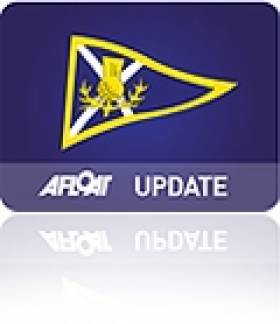Displaying items by tag: Justine
O'Leary Hunts for Third Scottish Title
Royal Cork's Anthony O'Leary, who has won the Scottish Series award twice, is in Tarbert bidding to win for a third time 30 years exactly since the Trophy first went to Ireland when it was won by Frank Woods on the Castro designed One Tonner Justine III. This year Irish travellers to Scotland are down as is the overall attendance for tomorrow's event.
For all that the total entry may have compacted down in recent years due largely to the pressures of the global economy and the net consequence of more carefully allocated holiday or leisure times, the core entry for the Brewin Dolphin Scottish Series is as richly laden with high quality talent and past winners as ever.
The north of Britain's most prestigious annual sailing regatta starts Friday morning and the 107 crews look like they are in for more breezy weather on Loch Fyne. Of course over more than 30 years of racing on the loch, strong winds are nothing new.
Regulars who year in year out set aside the May Bank Holiday weekend to race on the spectacular waters of the sea loch, have returned to work each Tuesday as often with sunburn as they have borne the obvious effects of four days in unrelenting wind and chilly temperatures.
But the majority of these next few days seem set to be given over to the latter.
It will matter little to the hard core. Four skippers will be looking to match Jonathan Anderson's record of three overall Scottish Series wins. Perhaps the best chance of achieving this hallowed hat-trick rests again with Hamish Mackay who won in consecutive years 2001 and 2002.
Ten years on from that last win Mackay, past Chairman of the Royal Yachting Association will be helping campaign a J97 Jackaroo in IRC Class 4, which recently dominated at the warm-up Savills Regatta on the Clyde winning the overall top trophy.
Clyde sailmaker John Highcock is also bidding for a third win of the overall top award, after helping veteran John Corson to secure the Brewin Dolphin Scottish Series Trophy last year with his Corby 33 Salamander XX. The same team which won last year remains intact, with the boat unchanged from victory last May.
Chris Bonar, who won in 1985 and 1997, returns with his crew on Bateleur 97, a BH36 which competes in IRC Class 1 up against Anthony O'Leary, from Royal Cork YC, who has also won the top award twice.
Racing starts Friday for all classes and concludes Monday.
"It looks like it will be a nice compact regatta during which we can maximise our ability to run good racing, and the amenity values of Tarbert will be at their highest. It is gratifying to see that the IRC and the CYCA Handicap classes' entries have stood up well. And after the event we will look a little closer at why the entries for some of the sporstboat and smaller one design classes are down," said John Readman, chair of the Brewin Dolphin Scottish Series organisers the Clyde Cruising Club.























